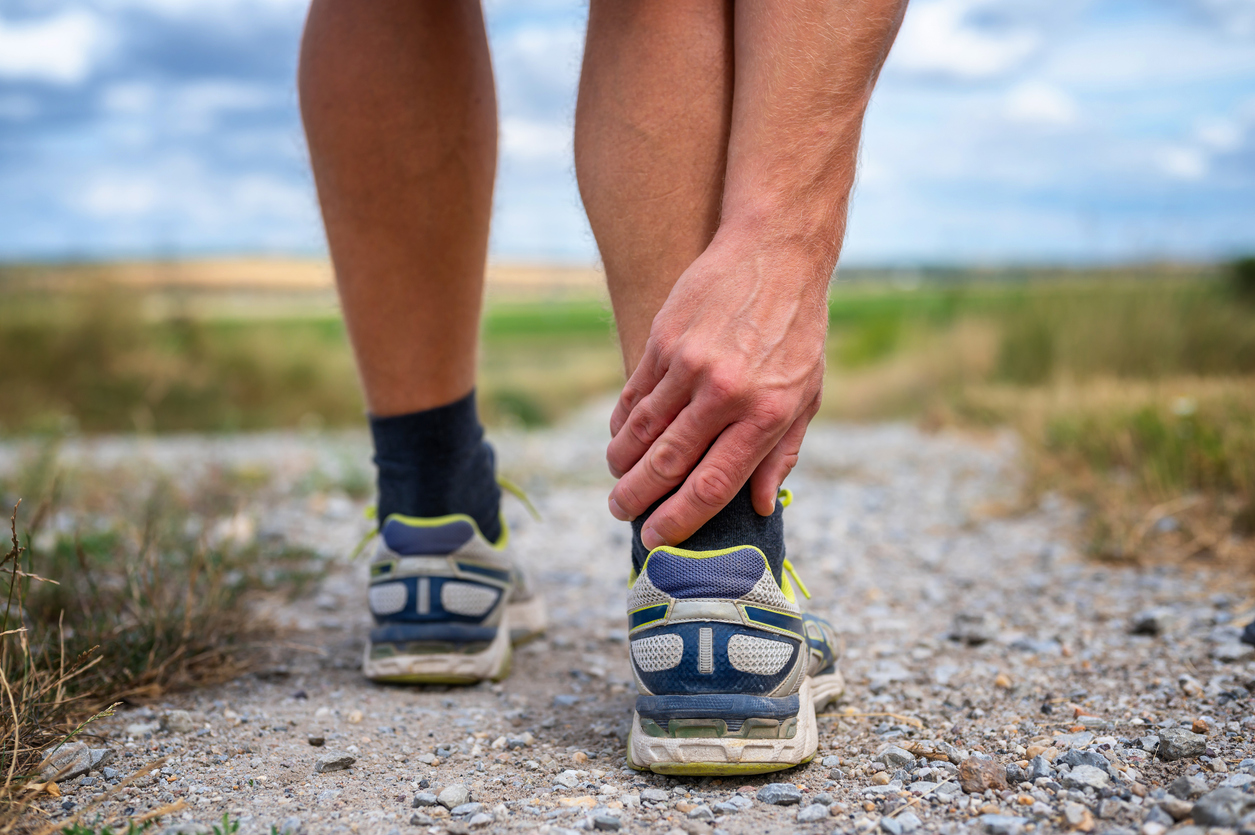By Gregory Caronis, MD – Orthopedic Foot & Ankle Surgeon, Fellowship-Trained
What Is the Achilles Tendon?
The Achilles tendon is the strong, rope-like structure connecting your calf muscles to your heel bone. It’s the largest tendon in your body and is essential for walking, running, and jumping. Because it endures such high stress with every step, it’s also prone to overuse and injury.
Achilles Tendonitis
What Is Achilles Tendonitis?
Achilles tendonitis is inflammation or irritation of the tendon. It develops gradually, often due to overuse, tight calf muscles, or repetitive strain from sports or daily activities.
There are two main types:
- Mid-substance (non-insertional) tendonitis – occurs a few centimeters above where the tendon attaches to the heel bone.
- Insertional tendonitis – affects the lower portion of the tendon where it inserts into the heel bone and may involve calcium buildup or bone spurs.
What are the Symptoms and Physical Exam Findings for Achilles Tendonitis?
Common symptoms include:
- Pain or stiffness along the back of the ankle, especially in the morning or after rest
- Swelling or thickening of the tendon
- Tenderness to touch
- Pain that worsens with activity or when wearing certain shoes
On examination, you may have tight calf muscles, a thickened tendon, or a small bony bump near the heel.
Imaging
- X-rays: May show calcification or bone spurs where the tendon attaches to the heel bone.
- MRI: Provides detailed images to confirm inflammation, small tears, or degeneration of the tendon fibers.
Non-Surgical Treatment
Most patients improve with non-operative care, which may include:
- Activity modification to reduce strain
- Rest, Ice, Compression, Elevation (RICE)
- Anti-inflammatory medication (ibuprofen, naproxen)
- Physical therapy and stretching, especially eccentric calf strengthening
- Heel lifts or custom orthotics
- Supportive footwear to reduce friction at the tendon’s attachment point
Recovery is gradual and can take several weeks to months.
Surgical Treatment for Insertional Achilles Tendonitis
When conservative measures don’t bring relief, surgery can be a very effective — and safe — solution. The goal is to remove the damaged tissue and bone spurs while restoring a healthy attachment between the tendon and the heel bone.
During surgery, I:
- Remove degenerated tendon tissue and calcium deposits
- Smooth any bony prominence (Haglund’s deformity)
- Reattach the tendon securely to the heel bone using strong anchors
These anchors are often advanced, low-profile systems such as the Arthrex SpeedBridge™ Achilles Repair System — designed to provide excellent fixation strength and allow a smoother tendon-to-bone healing surface.
This procedure is performed as outpatient surgery. Patients go home the same day, wear a protective boot for several weeks, and gradually begin weight-bearing and therapy. Most return to full activity in a few months with excellent long-term results.
Achilles Tendon Rupture
How It Happens
A rupture is a complete tear of the tendon fibers, typically occurring during sports or sudden movement. Many patients describe a distinct “pop” in the back of the ankle — often feeling like being kicked or struck — followed by sharp pain and weakness.
Symptoms and Physical Exam Findings
- Sudden pain and swelling in the back of the ankle
- Bruising that develops over several days
- Difficulty pushing off or standing on tiptoe
- A visible or palpable gap in the tendon just above the heel
Diagnosis
Diagnosis is based on physical exam and, if needed, confirmed with MRI to evaluate the extent of the tear and surrounding tissue condition.
Treatment Options
Non-Surgical Management
For patients who are less active or prefer to avoid surgery, non-operative care can yield good outcomes. This involves:
- Immobilization in a boot or cast
- Gradual return to motion with physical therapy
- Close follow-up to ensure proper healing
Non-operative treatment can work well if the tendon ends are well-aligned, though it generally requires a longer recovery and carries a slightly higher risk of re-rupture.
Surgical Repair
For active patients, surgery is often the best way to restore strength and performance.
The torn ends of the tendon are brought together and secured with specialized suture systems such as the Arthrex PARS Achilles Repair System, which allows a minimally invasive repair through small incisions.
Surgical benefits include:
- Lower risk of re-rupture
- Faster and more predictable recovery
- Greater long-term strength and performance
Patients typically go home the same day, begin early movement under guidance, and transition to walking in a boot over several weeks. Most return to sports and high-demand activity within 4–6 months.
The Bottom Line
Achilles tendon injuries can significantly impact your mobility and quality of life — but effective treatment options are available.
Whether you’re dealing with chronic tendonitis or an acute rupture, modern surgical and non-surgical care can get you back to the activities you enjoy.
As a fellowship-trained orthopedic foot and ankle surgeon, I provide comprehensive care for Achilles tendon problems, using evidence-based techniques and the latest technology to achieve excellent outcomes.
Schedule a Consultation
If you’re experiencing heel or Achilles pain, don’t wait for it to worsen. Early diagnosis and treatment can make a significant difference in recovery.
Gregory Caronis, MD
Orthopedic Foot & Ankle Surgeon – Northern Illinois

